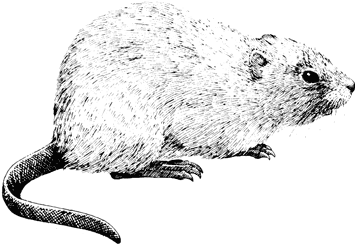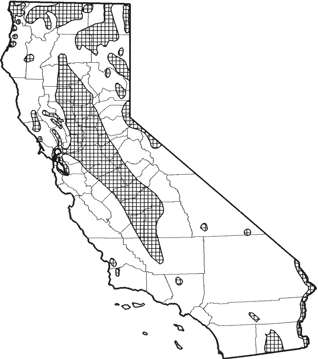
Common Muskrat
Distribution, Abundance, and Seasonality
Scattered occurrence in California, but continuously distributed along the Colorado River, in wetlands south of Salton Sea (Imperial Co.), the Sacramento and San Joaquin valleys (Shasta Co. south to Kern Co.), the San Francisco Bay area, and in the northern interior counties (Siskiyou, Modoc, Shasta, and Lassen). Abundant in fresh emergent wetland habitat. Common to abundant in valley foothill and montane riparian habitats, aspen, and lacustrine, riverine, and estuarine habitats. Also occupies human-made habitats such as roadside and irrigation ditches.

Range Map
Specific Habitat Requirements
Feeding: Mainly herbivorous, eating aquatic plants such as cattail and bulrush, either from the bank or underwater. Eats various parts of aquatic plants; favors roots and basal stems (Dannell 1978). Invertebrates (molluscs, crayfish) and vertebrates (turtles, fish) are eaten opportunistically. Food may be cached (Errington 1963).
Cover: Cover for escape from predators and reproduction is sought either in conical-shaped houses, built above the water level with the dominant emergent plants in the area, or in burrows excavated in waterway banks. Both a main house and a feeding house (often multiple) are maintained.
Reproduction: Nests are lined with fresh plant material and are located near the center of the house (Errington 1963). Young also may be born in coot or diving duck nests.
Water: Drinks water, but can survive 2-3 days on dew and plant succulence (Airola 1980).
Pattern: Permanent water bordered by aquatic vegetation.
Species Life History
Activity Patterns: Diurnal and nocturnal. In one study, greatest activity was shown to be between 1600 and 1700 hr, and between 2200 and 2300 hr (Stewart and Bider 1974). Rainfall stimulates earlier activity and increased individual movements. Active year-round.
Seasonal Movements / Migration: None.
Home Range: In a Maine marsh, home range averaged 0.46 ha (1.14 ac) (Takos 1944). Along linear waterways, home range averaged 411 m (1350 ft). In one study, most activity was concentrated within 15 m of the main lodge (see Willner et al. 1980).
Territory: Territorial aggression increases with reproductive activity. Both sexes defend territories, though females are more aggressive, often killing intruders (Errington 1963). Much individual, seasonal, and geographic variation in aggressive behavior.
Reproduction: Breeds year-round, weather permitting, in southern part of the state. In northern counties, reproduction is confined to spring and summer, peaking from April to June. Gestation from 25-30 days (Erickson 1963). Litter size averages 4-8 young (range 1-11). Two or 3 litters each yr is common (Willner et al. 1980). Fewer litters and smaller litter sizes are typical in marginal habitat. Sexual maturity is reached by most individuals the spring after birth.
Niche: Well adapted for aquatic existence, as evinced by partially webbed feet, laterally-flattened tail, and pelage with dense underfur. The muskrat is the most important aquatic furbearing mammal in North America. Some important competitors are nutrias, Norway rats, and water voles (Willner et al. 1980). Populations fluctuate markedly, and may be cyclic. The population trends of sympatric mink and muskrat seem to be linked (Bulmer 1974). The parasite list is long: 19 nematodes, 13 cestodes, 2 acanthocephalans, and 17 acarinans (McKenzie and Welch 1979). Can affect significant changes in marsh plant composition (Dannell 1978). Predators, in addition to humans, include minks, raccoons, and other large bird and mammal predators.
Comments: Burrowing activities can result in extensive damage to water impoundments and agricultural lowlands. Positive management measures include maintenance of permanent water, and vegetation buffers at water's edge. Giles (1978) provided a thorough discussion of muskrat management.
Sources & References
California Department of Fish and Game, 1999.
California's Wildlife, Sacramento, CA.
Written by: P. Brylski, reviewed by: H. Shellhammer, edited by: R. Duke
Airola, D. A., ed. 1980. California wildlife habitat relationships program: Northeast Interior Zone. Vol. IV. Mammals. U.S. Dep. Agric., For. Serv., Lassen Natl. For., Susanville, CA. 255pp. Bulmer, M. G. 1974. A statistical analysis of the 10-year cycle in Canada. J. Anim. Ecol. 43:701-718. Dannell, K. 1978. Ecology of the muskrat in northern Sweden. Rep. Natl. Swedish Environ. Protection Board. 157pp. Erickson, H. R. 1963. Reproduction, growth, and movement of muskrats inhabiting small water areas in New York State. NY Fish and Game J. 10:90-117. Errington, P. L. 1961. Muskrats and marsh management. Univ. Nebraska Press, Lincoln. 183pp. Errington, P. L. 1963. Muskrat populations. Iowa State Univ. Press, Ames. 665pp. Giles, R. H., Jr. 1978. Wildlife management. W. H. Freeman and Co., San Francisco. 416pp. MacArthur, R. A., and M. Aleksiuk. 1979. Seasonal microenvironments of the muskrat (Ondatra zibethicus) in a northern marsh. J. Mammal. 60:146-154. McKenzie, C. E., and H. E. Welch. 1979. Parasite fauna of the muskrat, Ondatra zibethicus (Linnaeus 1766), in Manitoba, Canada. Can. J. Zool. 57:640-646. Stewart, R. W., and J. R. Bider. 1974. Reproduction and survival of ditch-dwelling muskrats in southern Quebec. Can. Field-Nat. 88:420-436. Takos. M. J. 1944. Summer movements of banded muskrats. J. Wildl. Manage. 8:307-311. Willner, G. R., G. A. Feldhamer, E. E. Zucker, and J. A. Chapman. 1980. Ondatra zibethicus. Mammal. Species No. 141. 8pp.
California Animal Facts | California's Wildlife